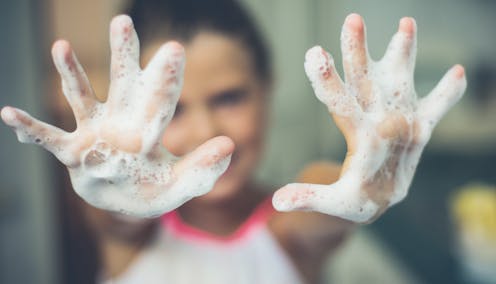How does soap keep you clean? A chemist explains the science of soap
- Written by Paul E. Richardson, Professor of Biochemistry, Coastal Carolina University

A microscopic view
To see what happens when you wash your hands with soap and water, let’s zoom in.
Picture all the gunk that you touch during the day and that builds up on your skin to make your hands dirty. Maybe there are smears of food, mud from outside, or even sweat and oils from your own skin.
All of that material is either water-loving or water-fearing on the molecular level. Dirt is a jumbled mess of both. Dust and dead skin cells are hydrophilic[15]; naturally occurring oils are hydrophobic[16]; and environmental debris can be either.
If you use only water to clean your hands, plenty will be left behind because you’d only remove the water-loving bits that dissolve in water.
But when you add a bit of soap, it’s a different story, thanks to its simultaneously water-loving and water-fearing properties.
Soap molecules come together and surround the grime on your hands, forming what’s known as a micelle structure[18]. On a molecular level, it looks almost like a bubble encasing the hydrophobic bit of debris. The water-loving heads of the soap molecules are on the surface, with the water-fearing tails inside the micelle. This structure traps the dirt, and running water washes it all away.
To get the full effect, wash your hands at the sink for at least 20 seconds[19]. Rubbing your hands together helps force the soap molecules into whatever dirt is there to break it up and envelope it.
It’s not just dirt
Along with dirt, your body is covered by microorganisms[20] – bacteria, viruses and fungi. Most are harmless and some even protect you from getting sick. But some microorganisms, known as pathogens, can cause illness and disease[21].
They can also cause you to smell if you haven’t taken a bath in a while. These bacteria break down organic molecules and release stinky fumes[23].
Although microorganisms are protected by a barrier – it’s called a membrane[24] – soap and water can disrupt the membrane, causing the microorganism to burst open. The water then washes the remains of the microorganism away, along with the stink.
To say that soap changed the course of civilization is an understatement. For thousands of years, it’s helped keep billions of people healthy. Think of that the next time Mom or Dad asks you to wash up – which will likely be sometime soon.
Hello, curious kids! Do you have a question you’d like an expert to answer? Ask an adult to send your question to CuriousKidsUS@theconversation.com[25]. Please tell us your name, age and the city where you live.
And since curiosity has no age limit – adults, let us know what you’re wondering, too. We won’t be able to answer every question, but we will do our best.
References
- ^ Curious Kids (theconversation.com)
- ^ CuriousKidsUS@theconversation.com (theconversation.com)
- ^ dates back approximately 5,000 years (theconversation.com)
- ^ country of Iraq (projects.iq.harvard.edu)
- ^ often made at home (www.pennsburymanor.org)
- ^ first soapmaking process (www.cleaninginstitute.org)
- ^ about US$50 billion every year (www.fortunebusinessinsights.com)
- ^ professor of chemistry (professorrichardsonresearch.com)
- ^ dihydrogen monoxide (socratic.org)
- ^ hydrophilic (www.biologyonline.com)
- ^ hydrophobic (study.com)
- ^ a round head and long tail (medicine.yale.edu)
- ^ soap is slippery (www.whyzz.com)
- ^ Tumeggy/Science Photo Library via Getty Images (www.gettyimages.com)
- ^ are hydrophilic (www.fau.eu)
- ^ are hydrophobic (www.scientificamerican.com)
- ^ TUMEGGY/Science Photo Library via Getty Images (www.gettyimages.com)
- ^ micelle structure (www.chem.ucla.edu)
- ^ at least 20 seconds (www.cdc.gov)
- ^ is covered by microorganisms (www.ncbi.nlm.nih.gov)
- ^ cause illness and disease (www.healthline.com)
- ^ velvelvel/iStock via Getty Images Plus (www.gettyimages.com)
- ^ release stinky fumes (theconversation.com)
- ^ it’s called a membrane (study.com)
- ^ CuriousKidsUS@theconversation.com (theconversation.com)
Authors: Paul E. Richardson, Professor of Biochemistry, Coastal Carolina University

